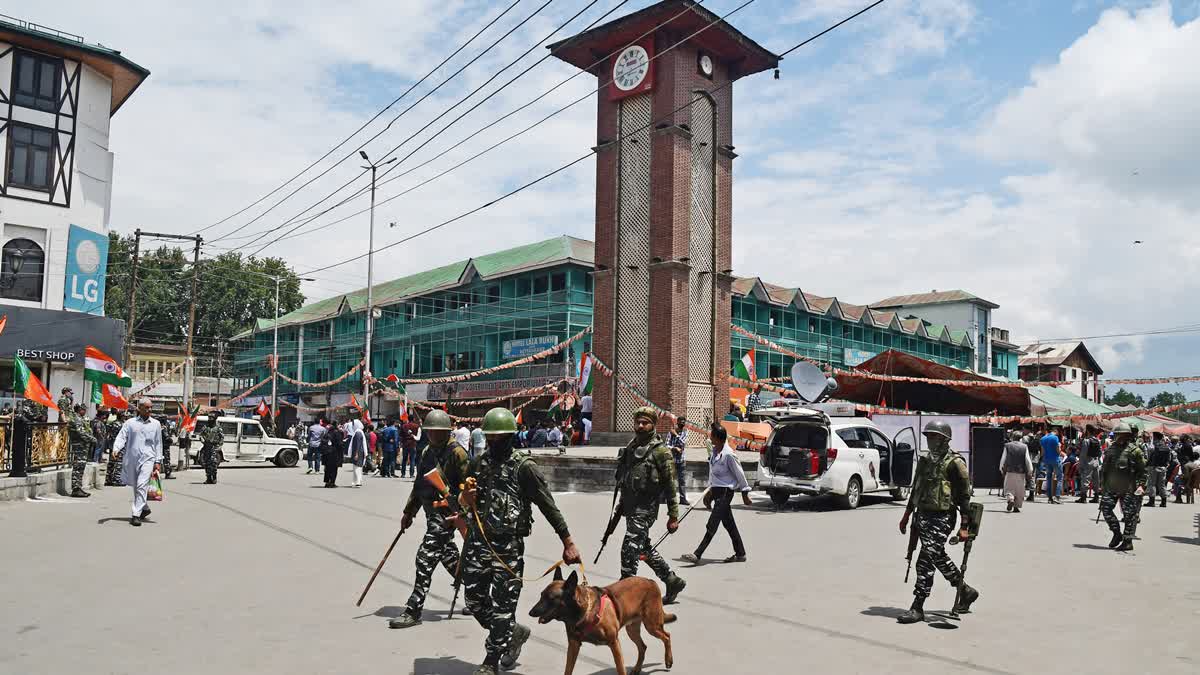Srinagar (Jammu and Kashmir):While Jammu and Kashmir is preparing for its first assembly elections since the abrogation of Article 370 and since 2014, the region's political landscape has undergone dramatic changes since its first elections in 1951. This evolution reflects a history of democratic development, shifting alliances, and significant constitutional shifts. Here's a comprehensive look at the major milestones in the region's electoral journey.
End Of Dogra Monarchy HeraldsDawn Of Democratic Governance: 1951
Following over a century of Dogra monarchy in Jammu and Kashmir, the erstwhile state held its first elections for its Constituent Assembly in 1951, a pivotal moment in framing the region's constitution. Under the leadership of Sheikh Abdullah, the National Conference (NC) secured a dominant position. This election was critical in establishing the region's early democratic framework. The position of Prime Minister, held by Abdullah, was later re-designated as Chief Minister, reflecting changes in political nomenclature and governance structures.
1953: Political turmoil ensued when Sheikh Abdullah was dismissed by Sardar Patel, then the Home Minister of India. The dismissal led to the appointment of Bakshi Ghulam Mohammad as the new Prime Minister. This period marked a shift in power dynamics and a realignment of political forces.
1963: The political environment became increasingly volatile due to the controversial issue of the "Mirpur Thana" controversy, which further strained relations between the regional government and the central authorities.
1964: The appointment of Ghulam Mohammad Sadiq as Chief Minister followed the dismissal of Bakshi Ghulam Mohammad. Sadiq's tenure was marked by efforts to stabilize the political environment and address the grievances of various factions. His tenure laid the groundwork for future political developments.
The Rise of Political Forces and Key Agreements: 1960s–1980s
1967: The assembly elections resulted in a hung verdict, with the National Conference emerging as the largest party but lacking an absolute majority. This led to the formation of a coalition government involving the Indian National Congress (INC) and other smaller parties, highlighting a fragmented political landscape.
1972: Syed Mir Qasim of the Indian National Congress became Chief Minister. His tenure was characterized by efforts to bridge the gap between the regional government and the central authorities, leading to significant political negotiations and agreements.
1975: Sheikh Abdullah returned to power following the Indira-Sheikh Accord. This accord was a landmark agreement between then-Prime Minister Indira Gandhi and Sheikh Abdullah, aimed at addressing regional grievances and restoring political normalcy. Abdullah's return marked the resurgence of the National Conference in J&K politics.
1977: The elections saw the National Conference securing a clear majority under Sheikh Abdullah. This victory ended the period of coalition governance and restored the NC's dominance in the region's politics. The election results underscored the party's strong support base and its ability to secure a majority in the assembly.
1986: The Rajiv-Farooq Accord, an agreement between Prime Minister Rajiv Gandhi and Chief Minister Farooq Abdullah, aimed to restore political stability and address regional unrest. However, the 1987 elections were marred by allegations of widespread rigging, fueling growing discontent and contributing to the rise of militancy in the region.
The Political Landscape: 1980s–2000s
1982: Dr Farooq Abdullah, son of Sheikh Abdullah, became Chief Minister. His tenure was marked by efforts to maintain stability amidst growing unrest and rising militancy.
1984: Ghulam Mohammad Shah, known as "Gul Shah," succeeded Farooq Abdullah in a controversial move. His brief tenure was characterized by political instability, leading to Abdullah's return to power.
1990–1996: The imposition of President's Rule, the longest period of direct central administration in J&K's history, reflected severe security challenges and a breakdown in regional governance.
1996: Farooq Abdullah returned to power following the end of President's Rule. The elections, conducted under challenging conditions, saw Abdullah's NC secure a majority, signaling a partial return to political normalcy.
The Emergence of New Political Forces: 2000s–Present
2002: The rise of the Peoples Democratic Party (PDP), led by Mufti Mohammad Sayeed, marked a significant shift. The PDP formed a coalition government with the Indian National Congress (INC), reflecting a new political configuration aimed at addressing regional issues and fostering cooperation.
2005: Ghulam Nabi Azad of the Congress became Chief Minister in a coalition with the PDP. His tenure, marked by efforts to address regional grievances and implement development initiatives, was cut short by the Amarnath land row, leading to the collapse of the coalition.
2008: The elections resulted in a hung assembly. The National Conference's Omar Abdullah formed a coalition government with the Congress, continuing the trend of coalition governance in a fragmented political environment.
2015: Mufti Mohammad Sayeed of the PDP formed a coalition government with the BJP. His tenure, which focused on regional development, was interrupted by his sudden death in 2016.
2016: Mehbooba Mufti, Sayeed's daughter, succeeded as Chief Minister, becoming the first woman to hold the office. Her tenure faced challenges from increasing political tensions and security issues. The BJP’s withdrawal of support in 2018 led to the imposition of Governor's Rule.
2019: A landmark event in Jammu and Kashmir’s history was the abrogation of Article 370, which led to the reorganization of the region into two Union Territories—Jammu & Kashmir and Ladakh. This constitutional change marked a significant shift in the region’s political and administrative structure.
Jamaat-e-Islami (JMI): A significant socio-religious organization in Jammu and Kashmir, it has influenced regional politics and was a part of the political landscape in the 1980s.
